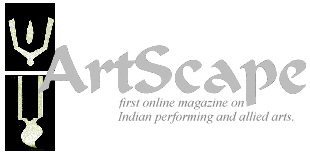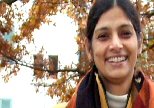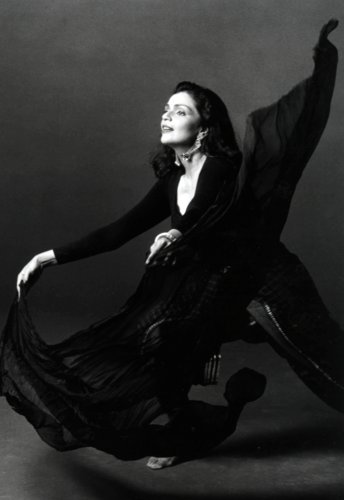ARTICLES
www.artindia.net
does not take any responsibility whatsoever
with regard to articles/ reviews/ previews /information published here.
Any suggestions/ comments /complaints etc. may be sent directly to the
writers/ contributors directly. We invite
you to contribute articles/ reviews etc. to ArtScape. You may sent in
your stories to art.india@yahoo.com along with scanned pictures.


ANJANA RAJAN is a senior correspondent with THE HINDU, national daily and a disciple of Rukmini Devi Arundale and a product of Kalakshetra.
OF AN OCEAN
by ANJANA RAJAN
The classical dances of India are essentially story-telling arts. Some of the names, such as Kathak and Kathakali, are even derived from the root word 'katha' meaning story. In fact the Natya Shastra in its chapter on the origin of dance describes how in the Treta yuga, the gods -- concerned at falling morals in the mortal world -- asked Brahma to create an edifying art that would not only provide lessons in ethics but also entertain the audience and practitioners. And who doesn't love a good story? So it was, says the author of the Natya Shastra, that Brahma devised the art of dance, culled from the essence of the four Vedas.
Down the ages, the basic source material for the traditional dance and theatre forms has been the huge treasure house of mythological lore from the puranas and other ancient scriptures. In this context, well known Bharata Natyam dancer Anita Ratnam's choreographic presentation, Daughters of an Ocean, based on Shobhita Punja's book of the same name, was both traditional and modern. Daughters of an Ocean retells the stories associated with the three goddesses of the Hindu pantheon, Saraswati, Lakshmi and Durga -- or Kali as she is known in her fierce aspect.
In a brief introduction to the show, Shobhita Punja rightly pointed out that unlike the mythology of other ancient cultures such as Greece and Rome, mythology in India remains a living tradition. It manifests itself in the daily rituals and habits we indulge in almost without realising; in our conversation; in linguistic imagery and in the way we perceive situations. This is reminiscent of how the Bible has become a part and parcel of the European languages. Such expressions as 'nothing new under the sun' and concepts like 'in the wilderness' in fact trace their origins to the Bible.
Anita Ratnam began with the theme of Lakshmi, who appeared during the Amrita Mathanam, when the Devas and Asuras joined hands to churn the great ocean to get from its depths amrit or the nectar of everlasting life. The choreography brought to mind images of water and waves. Dressed in simple white costumes, the group of dancers, taut and extremely fit, flowed from one formation to the other with effortless ease and a certain primal quietness.
The abstract choreography was extremely appealing. At times the choreographer joined the dancing and at others she moved to the front of the stage and spoke to the audience, narrating the various myths and linking them to episodes in her own life and family history. While the visual presentation was at all times stylized, whether in the movements of the dancers or the seated posture adopted by the narrator, the manner of talking to the audience was extremely casual. This could be said to reflect the dual attitude that devotees have towards their chosen god: both reverential and informal.

Anita Ratnam's use of three dimensional tableaux made up of two
or more dancers, with controlled asymmetry, is highly aesthetic. She uses
the basic postures of classical dance, such as araimandi, chowk (preritam),
etc., to develop a language that is classical but not necessarily classified
as Bharata Natyam or any other dance form by a particular name. Her interspersing
abstract dance sequences between informal narratives gave the show an
atmosphere of Harikatha kalakshepam, which is another popular tradition
of story-telling, and which uses music to enliven the narration of puranic
myths. And Anita Ratnam's references to her own childhood, her grandmothers,
etc., gave the goddesses a human connection in the same sort of vein that
Harikatha artists bring the gods and goddesses to life.
The interpretation was very personal, but then it is probably true that any adaptation of a particular work has to reflect the personal concerns and experiences of the artist who is adapting it. In any case the work deserves high regard since it is a product of one dedicated artist's appreciation of -- and inspiration from -- the work of an artist in another genre. Her treatment of the subject is also novel, at least in the present Indian classical dance scene which has become quite rigid in what it allows to be labeled as classical. The presentation would probably go down well with English speaking audiences in the West too, since it removes the haze of confusion from before the eyes of an audience uninitiated in classical dance, with narration in simple English and abstract choreography.
© Art India Net. ® 1998--2007. We welcome your suggestions and comments to improve this site. Please post an e-mail to add information.
Founder/ Content Editor/ Site Construction/ Maintenance: GS Rajan, Technical Advisor: Sudhir Gandotra Hosted by Communicators - Indserve Infotech P Ltd. © ®